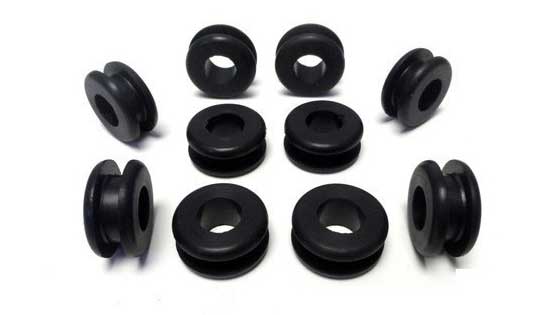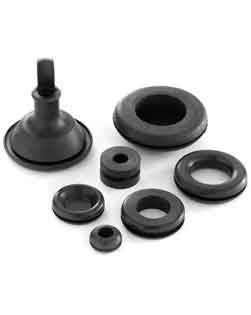Rubber grommets are any variation of eyelets or rings which are used as insulation devices. The term "grommet" had its origin in the garment industry and used as a type of fastener. Today, "grommet" has become an industrial standard term for cable management and modular wiring systems. Grommets are eyelets that are used to strengthen or protect an opening. They are also used to insulate and protect an object passing through an opening. They are inserted into a hole in a mechanical part to prevent grounding, chaffing or mechanical grounding. Rubber grommets are widely used to ensure safety and flexibility in the cable management system.


- Metal
- Plastic
- Rubber
- Butyl rubber or isobutylene isoprene elastomer
- This rubber is resistant to water, steam, alkalis, and oxygenated solvents.
- It has low gas permeation.
- It is capable of providing both high-energy absorption (dampening).
- It has good hot tear strength.
- Nitrile and styrene butadiene rubber (SBR)
- This rubber is used with most oils, hydraulic fluids and alcohol.
- A variety of proprietary compounds are available for specific applications.
Buying Tips
An analysis of physical specifications are required while selecting
grommets. For example:
- Shapes: Usually round, oval, oblong, square or rectangular.
- Inside diameter (ID): This is the diameter of the hole of the grommet and measured in millimeters or inches.
- Flange Diameter: This is the diameter of the outer flange provided in the grommet and measured in millimeters or inches.
- Length under Flange: This is the distance between the lower surface of the flange and the lower end of the grommet and measured in millimeters or inches.
- Material of Construction: Various options like stainless steel, zinc, aluminum, rubber, and plastic are commonly used in the manufacture of grommets.
- Molded and strain relief grommets remove the need for knot tying.
- They offer structural reliability.
- They eradicate any wounding through or fraying of the hole when ropes or wires are threaded through.
- Hard materials like metals have holes with pointed edges. This is risky for soft materials passing through the leads, thereby causing damage to the material. To prevent such a possibility, rubber or plastic grommets can be used to provide a protective lining to the hole.
- A rubber grommet allows wire and cabling to pass through floor beams and studs safely. It allows wires to be neatly and safely contained under a raised access floor.
- These grommets may look like a minor part of modular wiring systems but they are extremely important. They are a huge part of modular wiring systems, making cable management and modular wiring very safe and flexible.
Grommets have a wide range of applications:
- They are found in shoes, clothing, corsets, curtains, leather, and other fabrics. Grommets that are small in size are called eyelets and are used in clothes.
- Surge protectors, fax/modem lines, electrical wiring outlets and computer cables can be organized properly by using large oval and rectangular grommets.
- Grommets are also used on commercial tarp which is used to cover outdoor furniture, woodpiles or boats, cars etc.
- Cable management means managing large amounts of cabling under floors and this is done by using grommets.
- Anti Vibration Mountings
- Automobile Rubber Products
- Calendered Rubber Products
- Extruded Rubber Products
- Medical Rubber Products
- Metal Bonded Components
- Rubber Adhesives & Sealants
- Rubber Ball
- Rubber Bands
- Rubber Beading
- Rubber Bearing
- Rubber Belt
- Rubber Buckets
- Rubber Bullets
- Rubber Cable
- Rubber Coating
- Rubber Duct
- Rubber Expansion Joints
- Rubber Flooring/Matting
- Rubber Footwear
- Rubber Gloves
- Rubber Injection Parts
- Rubber Lining
- Rubber Magnets
- Rubber Molded Products
- Rubber Pads
- Rubber Rollers
- Rubber Stopper
- Rubber Suit
- Rubber Track
- Rubber Valve
- Rubber Balloon
- Rubber Stamps
- Rubber Fenders
- Acrylic Rubber (ACM)
- Butadiene Rubber (BR)
- Butyl Rubber (IIR)
- Chlorosulfonated Polyethylene(CSM)/ Hypalon
- Ethylene Propylene Diene Monomer
- Fluoroelastomers (FKM)/Viton
- Isoprene Rubber (IR)
- Nitrile Rubber (NBR)
- Perfluoroelastomer (FFKM)
- Polychloroprene (CR)/Neoprene
- Polysulfide Rubber (PSR)
- Silicone Rubber (SiR)
- Styrene Butadiene Rubber
How to Make a Custom Rubber Stamp?
Whenever designing a custom stamp for your company, never compromise on its quality because in the end it is the most...
Read MoreLatex and Silicone Rubber Tubing - A Comparison!
Many industries use rubber tubing for various purposes. In fact, various types of rubber tubing are used for different applications...
Read MoreSilicone vs Acrylic Adhesive- A Comparison
Silicon and acrylic adhesives are those rubber adhesives that are widely used in Polyimide tapes. In fact, the polyimide...
Read More

